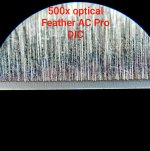eKretz
Diamond; Mod Squad
- Joined
- Mar 27, 2005
- Location
- Northwest Indiana, USA
The false color image does require the full wave plate.
The earlier transmission light DIC microscopes used a fixed position polarizer, fixed position analyzer, a DIC prisim mounted in the condenser and a sliding DIC prism behind the objective. The DIC slider was mounted in the 45 Deg position slot above the objective The slider could be moved within the slot by turning a screw to adjust the DIC image contrast (bias retardation). The system could measure the phase shift between the specimen light beam and the reference light beam if a micrometer screw was installed and one knew the relation between the screw position and the bias retardation. The De Senarmont setup allows one to measure the phase shift in angstroms by leaving the DIC slider in a fixed position The bias retardation can be measured by rotating the analyzer. The analyzer position can be read to within 1/10 degree. The resolution of the measurement is 5500 angstroms/ 3600 divisions or 1.5 angstroms. This is a much improved setup.
If your sliders are fixed in position then you have a microscope set up for De Senarmont DIC imaging. Do not modify the sliders containing the prisms. It is a step backwards in design and you may damage the prisms.
The DIC image contrast depends on very careful alignment of the crossed polarizer and analyzer, the orientation of the 1/4 wave plate fast axis with respect to the polarizer axis and a Kohler condenser setup. The alignment procedure is detailed in the Nikon tutorial web page. It is not a quick process The procedure will be about the same for incident light DIC with the exception that there is no condenser DIC prism to align.
My Zeiss Universal does not produce the high quality images shown in the alignment tutorial. There may be some strain in the originally strain free optics and the polarizing filters are showing signs of old age.
The full wave plate produces color contrast by removing the green portion of the light spectrum. Instead of white light illumination, the image has a magenta color band shifting to blue and yellow color bands with a change in bias retardation.
The modification won't damage anything. The original prisms flip in and out so that the scope can still be used in brightfield/darkfield/pol in addition to DIC. The modification only entailed removing a spring that forced the prism fully into position. It used to be that the prism could only be placed all the way in or all the way out. Now it can just be placed all the way in, all the way out or anywhere in between.
The analyzer for this scope only rotates from 0°- 45° - and is not otherwise graduated. I may try my hand at making my own analyzer with a little better control over rotation - and without the ¼ lambda plate just to see how it differs. The image quality is already very good, but I enjoy experimentation.






